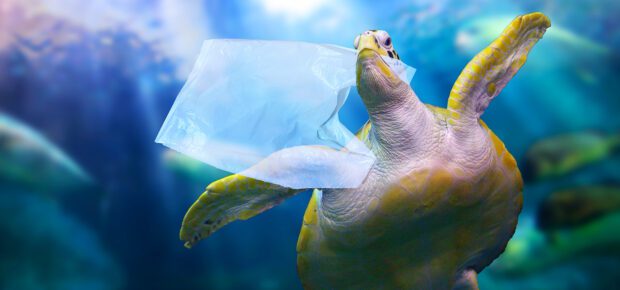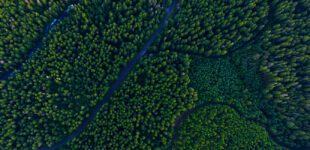March 21, 2023
How do researchers count microplastics in the ocean?
The world has good data on how much plastic is produced and how that plastic is used. But it’s really hard to tell what happens afterward. Some of it gets recycled, some goes to landfills. The rest? It leaks into the environment, either through air or on land.
Quite often, that plastic finds its way into the world’s oceans, where it damages delicate ecosystems in often unforeseen ways. By some estimates, the oceans may contain more plastic than fish by 2050.
Most plastic does not biodegrade. Rather, it breaks down into smaller and smaller pieces after being exposed to sunlight and mechanical forces, like the impact of waves on a beach. The behavior of all plastics, including microplastics, is not fully well understood. Some sinks, some floats, and some may be ingested by marine life.
All of which makes it hard to measure.
“Microplastics are everywhere, but finding the spots of high density is tricky because there’s vertical as well as horizontal movement in the ocean,” said IEEE Member Krista Beardy, who works on several projects involving microplastics in the ocean. “Plastics are predominantly buoyant, with a few exceptions. But as soon as they are colonized by any microfilm, they’re going to sink down to sediments where they are ingested by sediment dwellers. Then that plastic passes through the digestive system with the film removed, and it floats right back to the surface. So it’s hard to tell how much is actually trapped down there.”
Finding out how much plastic is in the oceans, and what happens once it is there could help dictate mitigation strategies. Engineers and technologists are using a variety of tools to measure plastic content in oceans.
Here’s a look at the latest:
- Deep learning models: The behavior of plastics in the oceans is influenced by waves, tides and wind, as well as the shape, size, and composition of the plastic itself. One strategy is to collect data on how plastics travel on ocean currents, feeding that data into a deep learning model. These models could then be used to identify potential accumulations of plastic on the surface, or below.
- Giant clams, mussels and other animals: Researchers often focus on the amount of plastics ingested by bivalves and other species that don’t move around so much as an indicator of plastic contamination at a given location. Based on where plastics are more concentrated in the animals, researchers can develop an understanding of where particles are coming from and how they travel through the waters.
Satellite-based radar: Researchers are beginning to use weather satellites to survey plastic concentrations over wide areas of open ocean. The idea is something like this: When the water is clean and free of debris, researchers have a pretty good idea of how it should behave given certain wind speeds and other conditions – this includes the small ripples across the surface as well as the large swells. But when ocean water has high concentrations of plastics, it behaves a little bit differently. Plastics and other compounds associated with them can “dampen” wind-driven oceans, making them less rough than they should be. This dampening effect can be measured by space-based weather satellites. By measuring the degree to which the ocean is less rough than it is expected to be, researchers can infer the amount of plastic content in the ocean, as discussed in this article from IEEE Transactions on Geoscience and Remote Sensing.
- Citizen science: Researchers are increasingly relying on citizen scientists to collect data on microplastics and ocean litter. Using members of the public has advantages – especially in terms of the number of people available for data collection and the wide area they can collect data from. Projects can include taking samples in coastal waters or on the shore; or spotting large pieces of debris, such as discarded fishing gear. Projects often use mobile applications to report their results.
One difficulty in measuring the plastic content in the oceans is that observation methods are limited in comparison to the vastness of the ocean. There tend to be lots of studies from shore, and near the mouths of rivers where plastics enter the ocean. In areas of the North Atlantic and North Pacific where lots of marine litter tends to accumulate, direct measurements of plastics are usually taken by plankton net trawling, which uses nets fine enough to capture single celled organisms to grab small particles from the ocean. Researchers then count the contents of the net. But that has drawbacks because it only samples a small area at a given time. The oceanographic community continues to look for ways to measure plastic content over large areas. Satellites are playing a huge role, but many methods will require overlapping studies and research to provide a comprehensive picture.
Removing plastics from the ocean, however, remains an extremely difficult task. Robots can be used to scoop up large pieces of plastic. Microplastics are a bigger challenge. Some pieces are so small that they pass through any net, and even the filtration systems of wastewater treatment plants that discharge into rivers.
Beardy recommends changes in consumer behavior to halt demand for plastics.
“To slow the production of microplastics, we need to lessen the need for new plastic production by recapturing plastic waste and returning it to the recycling and remanufacturing stream,” Beardy said. “Challenge your own plastic use: Do I need this? Is it reusable? What can I do with it after? Could I choose an alternative product?”
Learn more: Remote sensing and satellite observation is critical to monitoring ocean health. Check out this report from the IEEE Oceanic Engineering Society about recent research.






 Liquid Infrastructure: Our Planet's Most Precious Resource
Liquid Infrastructure: Our Planet's Most Precious Resource The Impact of Technology in 2025
The Impact of Technology in 2025 Quantum and AI: Safeguards or Threats to Cybersecurity?
Quantum and AI: Safeguards or Threats to Cybersecurity? Why AI Can't Live Without Us
Why AI Can't Live Without Us Bits, Bytes, Buildings and Bridges: Digital-Driven Infrastructure
Bits, Bytes, Buildings and Bridges: Digital-Driven Infrastructure Impact of Technology in 2024
Impact of Technology in 2024 Emerging AI Cybersecurity Challenges and Solutions
Emerging AI Cybersecurity Challenges and Solutions The Skies are Unlimited
The Skies are Unlimited Smart Cities 2030: How Tech is Reshaping Urbanscapes
Smart Cities 2030: How Tech is Reshaping Urbanscapes Impact of Technology 2023
Impact of Technology 2023 Cybersecurity for Life-Changing Innovations
Cybersecurity for Life-Changing Innovations Smarter Wearables Healthier Life
Smarter Wearables Healthier Life Infrastructure In Motion
Infrastructure In Motion The Impact of Tech in 2022 and Beyond
The Impact of Tech in 2022 and Beyond Cybersecurity, Technology and Protecting Our World
Cybersecurity, Technology and Protecting Our World How Technology Helps us Understand Our Health and Wellness
How Technology Helps us Understand Our Health and Wellness The Resilience of Humanity
The Resilience of Humanity Harnessing and Sustaining our Natural Resources
Harnessing and Sustaining our Natural Resources Creating Healthy Spaces Through Technology
Creating Healthy Spaces Through Technology Exceptional Infrastructure Challenges, Technology and Humanity
Exceptional Infrastructure Challenges, Technology and Humanity The Global Impact of IEEE's 802 Standards
The Global Impact of IEEE's 802 Standards Scenes of our Cyber Lives: The Security Threats and Technology Solutions Protecting Us
Scenes of our Cyber Lives: The Security Threats and Technology Solutions Protecting Us How Millennial Parents are Embracing Health and Wellness Technologies for Their Generation Alpha Kids
How Millennial Parents are Embracing Health and Wellness Technologies for Their Generation Alpha Kids Space Exploration, Technology and Our Lives
Space Exploration, Technology and Our Lives Global Innovation and the Environment
Global Innovation and the Environment How Technology, Privacy and Security are Changing Each Other (And Us)
How Technology, Privacy and Security are Changing Each Other (And Us) Find us in booth 31506, LVCC South Hall 3 and experience the Technology Moon Walk
Find us in booth 31506, LVCC South Hall 3 and experience the Technology Moon Walk Virtual and Mixed Reality
Virtual and Mixed Reality How Robots are Improving our Health
How Robots are Improving our Health IEEE Experts and the Robots They are Teaching
IEEE Experts and the Robots They are Teaching See how millennial parents around the world see AI impacting the lives of their tech-infused offspring
See how millennial parents around the world see AI impacting the lives of their tech-infused offspring Take the journey from farm to table and learn how IoT will help us reach the rising demand for food production
Take the journey from farm to table and learn how IoT will help us reach the rising demand for food production Watch technical experts discuss the latest cyber threats
Watch technical experts discuss the latest cyber threats Explore how researchers, teachers, explorers, healthcare and medical professionals use immersive technologies
Explore how researchers, teachers, explorers, healthcare and medical professionals use immersive technologies Follow the timeline to see how Generation AI will be impacted by technology
Follow the timeline to see how Generation AI will be impacted by technology Learn how your IoT data can be used by experiencing a day in a connected life
Learn how your IoT data can be used by experiencing a day in a connected life Listen to technical experts discuss the biggest security threats today
Listen to technical experts discuss the biggest security threats today See how tech has influenced and evolved with the Games
See how tech has influenced and evolved with the Games Enter our virtual home to explore the IoT (Internet of Things) technologies
Enter our virtual home to explore the IoT (Internet of Things) technologies Explore an interactive map showcasing exciting innovations in robotics
Explore an interactive map showcasing exciting innovations in robotics Interactively explore A.I. in recent Hollywood movies
Interactively explore A.I. in recent Hollywood movies Get immersed in technologies that will improve patients' lives
Get immersed in technologies that will improve patients' lives